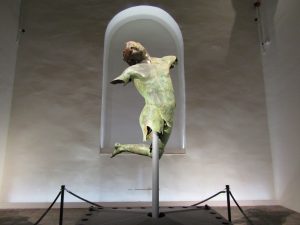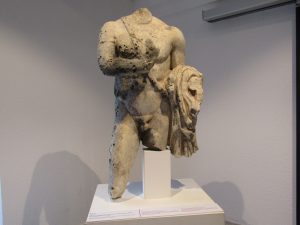Visiting and recording the sculptures from underwater deposits in the museums of Sicily - 2019
Katerina Velentza

From the 2nd to the 6th of May 2019 a research trip funded by the Honor Frost Foundation took place in Sicily with the aim to record ancient sculptural artefacts that have been recovered from underwater deposits. This project is part of my PhD research on ‘The Maritime Transport of Sculptures in the Ancient Mediterranean’ conducted in the University of Southampton under the supervision of Dr Julian Whitewright and Professor Simon Keay. This project examines the maritime transport of freestanding sculptures in the Mediterranean Sea from approximately the 7th/6th centuries BCE to the 6th century CE.
In order to comprehend why, when, and how freestanding sculptures of different materials and sizes were transported by sea in antiquity, this research focuses on the underwater contexts in which ancient sculptures have been found. It combines the perspectives of classical and maritime archaeology, and uses a dual methodological approach in the examination of the relevant data. The first, macro scale approach comprises a wide-ranging examination of underwater archaeological evidence for the transport of freestanding sculptures. This involves mainly the thorough study of several available sources and the creation of an extensive database that records known cases of freestanding sculptures deposited in the Mediterranean Sea while being transported in antiquity. The second, micro scale approach involves the in-depth study of individual shipwreck sites with freestanding sculptural artifacts. Since this project does not involve any underwater excavation or survey, the micro scale research consists in either close scrutiny of extant archaeological archives, reports and publications, or in this investigator’s primary recording and study of artifacts kept in museums or archaeological collections around the Mediterranean after their removal from the seabed.

During this five–day research trip I visited the Museum of the Museo del Satiro Danzante di Mazara del Vallo, the Museo Archeologico Regionale Lilibeo di Marsala – Baglio Anselmi and the Museo Archeologico Regionale Paolo Orsi in Syracuse, where I was able to record in person several already known but not extensively published sculptures retrieved from the sea off Sicily. Additionally, after going through the galleries of the museums mentioned above I was able to discover new data regarding the condition of the discovery of the sculptures of my research as well as information on other artefacts discovered in close vicinity to the sculptures. Finally, in the museum galleries I found new, previously unknown and unpublished, sculptural artefacts from underwater.
From my research visits in the archaeological museums of Sicily I was able to record previously unpublished details and data regarding several incidents of sculptures found underwater at the sea around the island, all of which are incorporated as entries in the database of my PhD. These sculptures seem to be very comparable to other similar sculptural discoveries found all around the Mediterranean Sea from the coast of the Iberian peninsula all the way to the Black Sea, Asia Minor and the Levantine coast. Despite the regular form of these archaeological discoveries, the current display and interpretation of the sculptures from underwater in the local museums of Sicily show overall a lack of understanding and scientific archaeological recording of the underwater context of these artefacts. Therefore, these sculptural pieces are deficient in information that would help us understand the circumstances and reasons for their maritime transportation and consequently their underwater deposition, unlike other case studies recorded in my PhD. Moreover, these artefacts and their contexts are currently in danger of looting, destruction and illicit trade due to the lack of recognition of their importance as archaeological sites that require archaeologically supervised operations for any underwater activity or intervention.

Following my research in the museums of Sicily I incorporated all of the data I collected in my PhD database, the analysis of which is planned to be published next year in an academic journal. Ultimately it is hoped that the outcomes of this PhD will inspire both classical and maritime archaeologists of Sicily and of the Mediterranean in general to conduct systematic research and therefore fully understand the scale and conditions of the maritime transport of sculptures in Antiquity.
